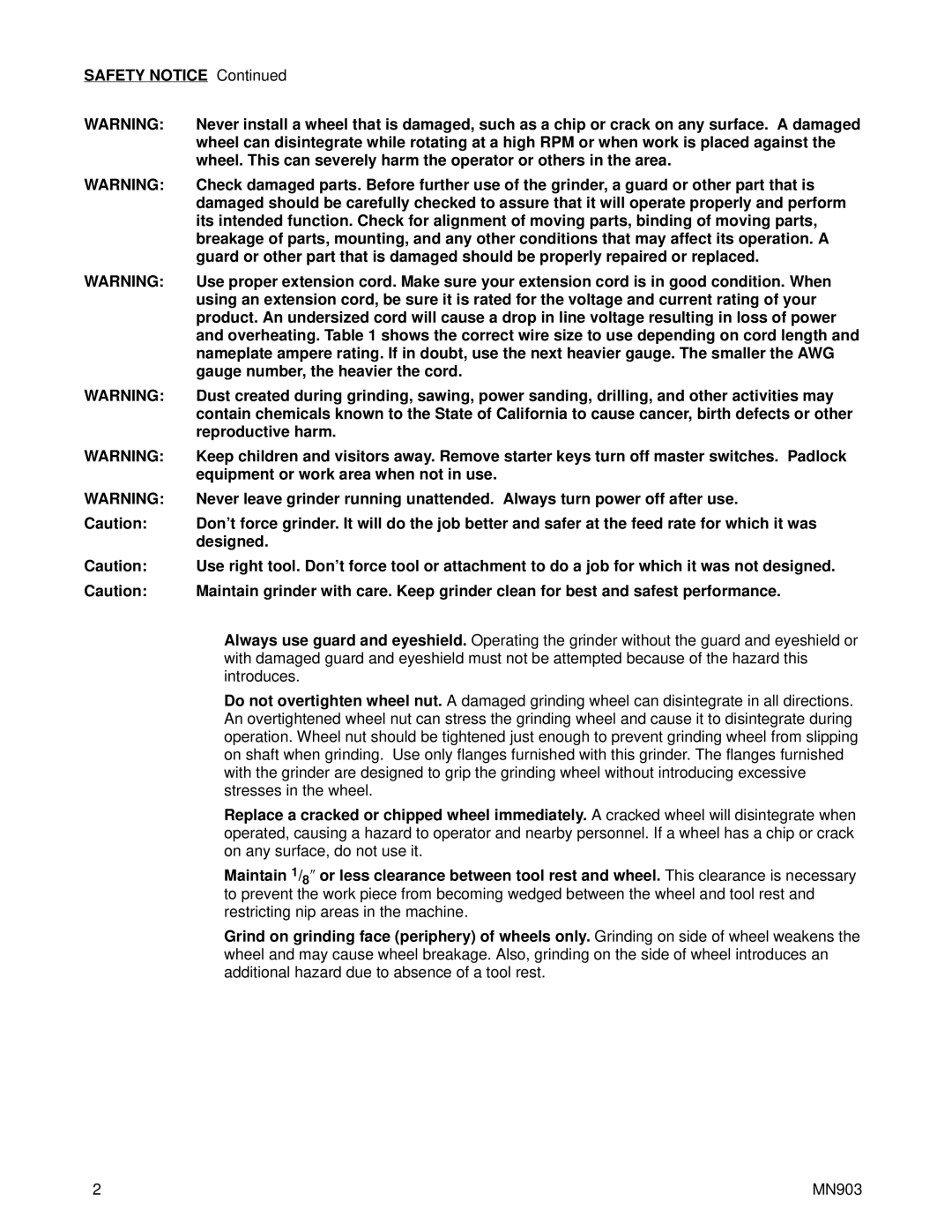SAFETY NOTICE Continued
WARNING: | Never install a wheel that is damaged, such as a chip or crack on any surface. A damaged |
| wheel can disintegrate while rotating at a high RPM or when work is placed against the |
| wheel. This can severely harm the operator or others in the area. |
WARNING: | Check damaged parts. Before further use of the grinder, a guard or other part that is |
| damaged should be carefully checked to assure that it will operate properly and perform |
| its intended function. Check for alignment of moving parts, binding of moving parts, |
| breakage of parts, mounting, and any other conditions that may affect its operation. A |
| guard or other part that is damaged should be properly repaired or replaced. |
WARNING: | Use proper extension cord. Make sure your extension cord is in good condition. When |
| using an extension cord, be sure it is rated for the voltage and current rating of your |
| product. An undersized cord will cause a drop in line voltage resulting in loss of power |
| and overheating. Table 1 shows the correct wire size to use depending on cord length and |
| nameplate ampere rating. If in doubt, use the next heavier gauge. The smaller the AWG |
| gauge number, the heavier the cord. |
WARNING: | Dust created during grinding, sawing, power sanding, drilling, and other activities may |
| contain chemicals known to the State of California to cause cancer, birth defects or other |
| reproductive harm. |
WARNING: | Keep children and visitors away. Remove starter keys turn off master switches. Padlock |
| equipment or work area when not in use. |
WARNING: | Never leave grinder running unattended. Always turn power off after use. |
Caution: | Don’t force grinder. It will do the job better and safer at the feed rate for which it was |
| designed. |
Caution: | Use right tool. Don’t force tool or attachment to do a job for which it was not designed. |
Caution: | Maintain grinder with care. Keep grinder clean for best and safest performance. |
| Always use guard and eyeshield. Operating the grinder without the guard and eyeshield or |
| with damaged guard and eyeshield must not be attempted because of the hazard this |
| introduces. |
| Do not overtighten wheel nut. A damaged grinding wheel can disintegrate in all directions. |
| An overtightened wheel nut can stress the grinding wheel and cause it to disintegrate during |
| operation. Wheel nut should be tightened just enough to prevent grinding wheel from slipping |
| on shaft when grinding. Use only flanges furnished with this grinder. The flanges furnished |
| with the grinder are designed to grip the grinding wheel without introducing excessive |
| stresses in the wheel. |
| Replace a cracked or chipped wheel immediately. A cracked wheel will disintegrate when |
| operated, causing a hazard to operator and nearby personnel. If a wheel has a chip or crack |
| on any surface, do not use it. |
| Maintain 1/ , or less clearance between tool rest and wheel. This clearance is necessary |
| 8 |
| to prevent the work piece from becoming wedged between the wheel and tool rest and |
| restricting nip areas in the machine. |
| Grind on grinding face (periphery) of wheels only. Grinding on side of wheel weakens the |
| wheel and may cause wheel breakage. Also, grinding on the side of wheel introduces an |
| additional hazard due to absence of a tool rest. |
2 | MN903 |
